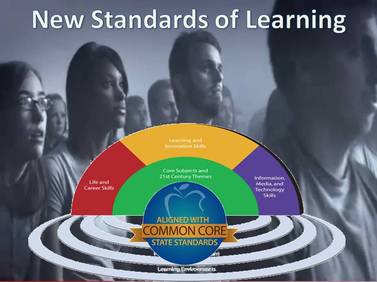
Most schools or school districts who's states have transitioned over to the Common Core are faced with moving away from traditional settings for learning in which individual subject matter skill sets has been taught in isolation. The traditional setting for learning can be described as a mechanized place where content is delivered on a conveyer belt of textbook driven, frontal deliverance system. Traditional means task-based, where curriculum rote memory of curriculum indicators thrive on handouts with fill-in-the-blank textbook searches that require find-the-missing-word-in-the-sentence approach to learning. Moving away from the isolation of state mandated curriculums to National standards housed within the Common Core will provide a more unified approach to learning requirements. Yet, there are many unanswered questions about how local districts will construct these new Common Core Standards as they define College and Career Readiness.
College-ready knowledge and skills, and performance expectations should be expressed not just in academic knowledge, but also in contextual skills, digital literacy awareness and key cognitive strategies that support problem solving in real life applications. This is why education should step back and take time to reexamine the interpretations of College and Career Readiness. What does it really mean to be college and career ready and how does these definitions play out in curriculum development? Thus the argument here might be that just outlining and developing Common Core standards into units of study might not be enough to satisfy the skills needed for College and Career readiness.
A recent blog post by Jay McTighe entitled Common Core Big Idea series confirms the importance ensuring clarity of Common Core Standards by fitting the pieces together. He uses his model of Understanding by Design to suggested various ways of unpacking standards. He states that "When working with the Common Core, we recommend that educators “unpack” them into four broad categories -- 1) Long-term Transfer Goals, 2) Overarching Understandings, 3) Overarching Essential Questions, and 4) a set of recurring Cornerstone Tasks." One important term outlined in this four point framework for design is overarching. "The term, overarching, conveys the idea that these understandings and questions are not limited to a single grade or topic. On the contrary, it is expected that they be addressed across the grades with application to varied topics, problems, texts and contexts." This definition is important for all curriculum developers for it outlines a process that may mean that the traditional pacing guide established by most districts in the past are no longer valid way to construct curriculum. What the term overarching may define is a spiral curriculum that requires a recurrence of performance based skills. A Spiral Curriculum is a repeated study of a standard at different grade levels, each time at a higher level of difficulty and in greater depth.
These performance based skills should be progressively constructed within the curriculum from simpler to more sophisticated levels of task completion. This type of progressive construction of curriculum standards can be defined as a growth curriculum enabling educators and learners to track performance. According to McTighe "Cornerstone task enable both educators and learners to track performance and document the fact that students are getting progressively better at using content knowledge and skills in worthy performances." Adopting 21st Century learning skills through a definition of College and Career Readiness and integrating National Education Technology Standards within the Common Core will create a curriculum that is both challenging and meaningful. The process of adopting both NET Standards and 21st Century learning skills into the Common Core curriculum has several stages of development that include; (1) constructing a curriculum web to weave together common standards of learning, (2) applying the rigorous relevance framework to determining real life themes of study through the establishment of an essential question and creating multidimensional task, (3) designing performance based assessments for real world applications and (4) developing unit maps that are tied to multiple standards. To complete this process successfully should promote high yield instructional practices by bringing together elements of the Common Core curriculum, assessment, and instruction (of materials and practices) into a coherent, workable unit of study. The four tools required to complete a unit of study are assembled around the PBL Unit Development Tool Kit.
College-ready knowledge and skills, and performance expectations should be expressed not just in academic knowledge, but also in contextual skills, digital literacy awareness and key cognitive strategies that support problem solving in real life applications. This is why education should step back and take time to reexamine the interpretations of College and Career Readiness. What does it really mean to be college and career ready and how does these definitions play out in curriculum development? Thus the argument here might be that just outlining and developing Common Core standards into units of study might not be enough to satisfy the skills needed for College and Career readiness.
A recent blog post by Jay McTighe entitled Common Core Big Idea series confirms the importance ensuring clarity of Common Core Standards by fitting the pieces together. He uses his model of Understanding by Design to suggested various ways of unpacking standards. He states that "When working with the Common Core, we recommend that educators “unpack” them into four broad categories -- 1) Long-term Transfer Goals, 2) Overarching Understandings, 3) Overarching Essential Questions, and 4) a set of recurring Cornerstone Tasks." One important term outlined in this four point framework for design is overarching. "The term, overarching, conveys the idea that these understandings and questions are not limited to a single grade or topic. On the contrary, it is expected that they be addressed across the grades with application to varied topics, problems, texts and contexts." This definition is important for all curriculum developers for it outlines a process that may mean that the traditional pacing guide established by most districts in the past are no longer valid way to construct curriculum. What the term overarching may define is a spiral curriculum that requires a recurrence of performance based skills. A Spiral Curriculum is a repeated study of a standard at different grade levels, each time at a higher level of difficulty and in greater depth.
These performance based skills should be progressively constructed within the curriculum from simpler to more sophisticated levels of task completion. This type of progressive construction of curriculum standards can be defined as a growth curriculum enabling educators and learners to track performance. According to McTighe "Cornerstone task enable both educators and learners to track performance and document the fact that students are getting progressively better at using content knowledge and skills in worthy performances." Adopting 21st Century learning skills through a definition of College and Career Readiness and integrating National Education Technology Standards within the Common Core will create a curriculum that is both challenging and meaningful. The process of adopting both NET Standards and 21st Century learning skills into the Common Core curriculum has several stages of development that include; (1) constructing a curriculum web to weave together common standards of learning, (2) applying the rigorous relevance framework to determining real life themes of study through the establishment of an essential question and creating multidimensional task, (3) designing performance based assessments for real world applications and (4) developing unit maps that are tied to multiple standards. To complete this process successfully should promote high yield instructional practices by bringing together elements of the Common Core curriculum, assessment, and instruction (of materials and practices) into a coherent, workable unit of study. The four tools required to complete a unit of study are assembled around the PBL Unit Development Tool Kit.

 RSS Feed
RSS Feed